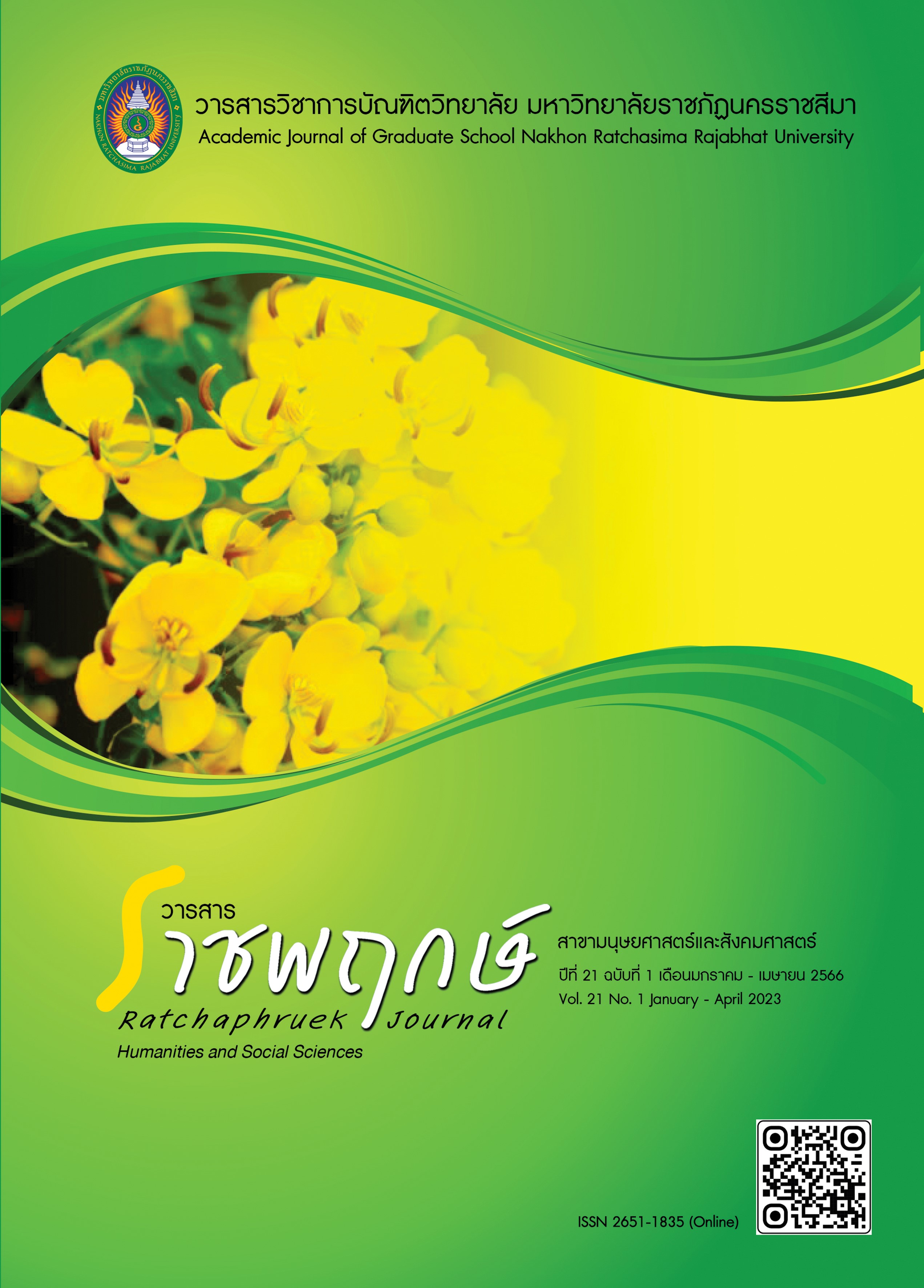The Scientific Literacy in “Food and Nutrition” for Upper Secondary School Students’
Main Article Content
Abstract
Scientific literacy is an essential element of science learning, especially for assessing students’ scientific knowledge and competencies both in national and international level. This research aimed to explore upper secondary school student's scientific literacy who studied the fundamental science courses from a school located in Bangkok. Data was collected from 201 students using the scientific literacy test in the topic of “Food and Nutrition” by convenience sampling. The test consisted of multiple-choices, complex multiple-choices, and short answers. The data were analyzed by the percentage, mean, and standard deviation. The results revealed that 190 students were at Level 2 and lower. and none of them were at Level 5-6. In addition, students had low average score, lower than 50 percents of the full score, in all competencies. Explain phenomena scientifically had a highest average score, followed by an interpret data and evidence scientifically. Evaluate and design scientific enquiry had a lowest average score. These results reflect that science educators need to put much more emphasis on improving students’ scientific literacy in upper secondary school level.
Article Details

This work is licensed under a Creative Commons Attribution-NonCommercial-NoDerivatives 4.0 International License.
References
กุลธิดา ชนาภิมุข. (2561). การจัดการเรียนรู้ตามแนวคิดวิทยาศาสตร์ เทคโนโลยี สังคม และสิ่งแวดล้อม เพื่อพัฒนาความฉลาดรู้ด้านวิทยาศาสตร์ เรื่อง การเจริญเติมโตของพืชดอก ของนักเรียนชั้นมัธยมศึกษาปีที่ 5 (วิทยานิพนธ์มหาบัณฑิต, มหาวิทยาลัยนเรศวร).
กระทรวงสาธารณสุข. (2562). คลังความรู้ กระทรวงสาธารณสุข. สืบค้นเมื่อ 15 มิถุนายน 2564, จาก http://klb.ddc.moph.go.th/
ชาตรี ฝ่ายคำตา. (2552). การจัดการเรียนรู้แบบสืบเสาะหาความรู้. วารสารศึกษาศาสตร์ มหาวิทยาลัยนเรศวร, 11(1), น. 32-45.
ชวนพิศ คณะพัฒน์. (2559). ผลการใช้รูปแบบการเรียนรู้วิทยาศาสตร์ตามแนวคิดการใช้ปัญหานำทางและการวิพากษ์วิจารณ์ทางสังคมและแนวคิดวิทยาศาสตร์ เทคโนโลยีและสังคม เพื่อส่งเสริมการรู้วิทยาศาสตร์ สำหรับนักเรียนระดับชั้นมัธยมศึกษาตอนต้น. วารสารวิชาการเครือข่ายบัณฑิตศึกษา มหาวิทยาลัยราชภัฏภาคเหนือ, 6(11), น. 67-79.
นวลพรรณ ไชยชนะ. (2564). ผลการจัดการเรียนรู้โดยใช้บริบทเป็นฐานร่วมกับเทคนิคการใช้คำถามที่ส่งผลต่อความสามารถในการอธิบายปรากฏการณ์ในเชิงวิทยาศาสตร์ ของนักเรียนชั้นประถมศึกษาปีที่ 4. วารสารบัณฑิตวิจัย, 12(2), น. 31-44.
พุทธริธร บูรณสถิตวงศ์. (2559). การสำรวจสมรรถนะการอธิบายปรากฏการณ์ในเชิงวิทยาศาสตร์และสมรรรถนะการแปลความหมายข้อมูลและประจักษ์พยานในเชิงวิทยาศาสตร์ตามกรอบการประเมิน PISA 2015 ของนักเรียนชั้นมัธยมศึกษาปีที่ 4 แห่งหนึ่งในจังหวัดพิษณุโลก. วิจัยและนวัตกรรม ขับเคลื่อนเศรษฐกิจและสังคม, 13(1), น. 1019-1031.
พรเทพ จันทราอุกฤษฎ์. (2556). การพัฒนารูปแบบการเรียนการสอนโดยบูรณาการรูปแบบการสืบสอบแบบโต้แย้งและแนวคิดการเรียนรู้โดยใช้แบบจำลองเป็นฐานเพื่อเสริมสร้างสมรรถนะการรู้วิทยาศาสตร์และความมีเหตุผลของนักเรียนมัธยมศึกษาตอนต้น (วิทยานิพนธ์ดุษฎีบัณฑิต, จุฬาลงกรณ์มหาวิทยาลัย).
โรงพยาบาลเกษมราษฎร์. (2557). อาหารกับสุขภาพ. สืบค้นเมื่อวันที่ 15 มกราคม 2564, จาก https://www.kasemrad.co.th/Sriburin/th/site/health_articles/detail/351
วรรณพงษ์ สุทธิเวสน์วรากุล. (2563). การวิจัยปฏิบัติการเพื่อพัฒนาการรู้วิทยาศาสตร์ เรื่อง กายวิภาคศาสตร์และสรีรวิทยาสัตว์โดยการจัดการเรียนรู้ด้วยวิธีการสืบเสาะ แบบโต้แย้ง สำหรับนักเรียนชั้นมัธยมศึกษาปีที่ 5. วารสารมนุษยศาสตร์ และสังคมศาสตร์ มหาวิทยาลัยอุบลราชธานี, 11(2), น. 254-279.
สุนีย์ คล้ายนิล. (2555). การศึกษาวิทยาศาสตร์ไทย: การพัฒนาและภาวะถดถอย. กรุงเทพฯ: แอดวานส์ พริ้นติ้ง เซอร์วิช.
สุนีย์ คล้ายนิล, ปรีชาญ เดชศรี และอัมพลิกา ประโมจนีย์. (2551). ความรู้และสมรรถนะทางวิทยาศาสตร์สำหรับวันพรุ่งนี้. กรุงเทพฯ: เซเว่นพริ้นดิ้ง กรุ๊ป.
สถาบันส่งเสริมการสอนวิทยาศาสตร์และเทคโนโลยี. (2545). การจัดการเรียนรู้กลุ่ม วิทยาศาสตร์หลักสูตรการศึกษาขั้นพื้นฐาน. กรุงเทพฯ: กระทรวงศึกษาธิการ.
สถาบันส่งเสริมการสอนวิทยาศาสตร์และเทคโนโลยี. (2561). ผลการประเมิน PISA 2015 วิทยาศาสตร์ การอ่านและคณิตศาสตร์ ความเป็นเลิศและความเท่าเทียมกันทางการศึกษา. กรุงเทพฯ: ซัคเซสพับลิเคชัน.
สถาบันส่งเสริมการสอนวิทยาศาสตร์และเทคโนโลยี. (2562). วิทยาศาสตร์กายภาพ เล่ม 1. กรุงเทพฯ: จุฬาลงกรณ์มหาวิทยาลัย.
สถาบันส่งเสริมการสอนวิทยาศาสตร์และเทคโนโลยี. (2563). ผลการประเมิน PISA 2018: นักเรียนไทยวัย 15 ปี รู้และทำอะไรได้บ้าง. สืบค้นเมื่อวันที่ 12 มกราคม 2564, จาก https://pisathailand.ipst.ac.th/issue-2019-48/
สำนักงานเลขาธิการสภาการศึกษา. (2560). แผนการศึกษาแห่งชาติ พ.ศ. 2560-2579. กรุงเทพฯ: พริกหวานกราฟฟิค.
สินีนาฏ จันทะภา. (2563). “ฐานสมรรถนะ” และ “ความฉลาดรู้” คำสำคัญที่ควรตระหนักการดำเนินงานของ สสวท. เพื่อ “ยกระดับการศึกษาไทย” ให้ก้าวทันสู่ศตวรรษที่ 21. นิตยสาร สสวท., 49(227), น. 3-6.
Arief, M. K. and Utari, S. (2015). Implementation of Levels of Inquiry on Science Learning to Improve Junior High School Student’s Scientific Literacy Penerapan Levels of Inquiry Pada Pembelajaran Ipa Untuk Meningkatkan Literasi Sains Siswa Smp. Journal Pendidikan Fisika, 11(2), pp. 117-125.
Hodson, D. (2008). Towards scientific literacy: A teacher’s guide to the history, philosophy and sociology of science. Rotterdam: Sense.
Lewis, L. (2003). Environmental Modeling and Issue-Based Teaching in Science Education. Retrieved May 5, 2020, from http://www.actionbioscience.org/education/lewis.html
Organization for Economic Co-operation and Development (OECD). (2016). PISA 2015 Assessment and Analytical Framework: Science, Reading, Mathematic and Financial Literacy. Paris: OECD Publishing.
Organization for Economic Co-operation and Development (OECD). (2019). PISA 2018 Assessment and Analytical Framework. Paris: OECD.
Surpless, B., Bushey, M. & Halx, M. (2014). Developing scientific literacy in introductory laboratory courses: A model for course design and assessment. Journal of Geoscience Education, 62(2), pp. 244-263.
United Nations. (2015). Sustainable development goal 4. Retrieved May 5, 2020, from https://sustainabledevelopment.un.org/sdg4
Zeidler, D. L. and Keefer, M. (2003). The role of moral reasoning and the status of Socioscientific issues in science education. Netherlands: Kluwer Academic.


